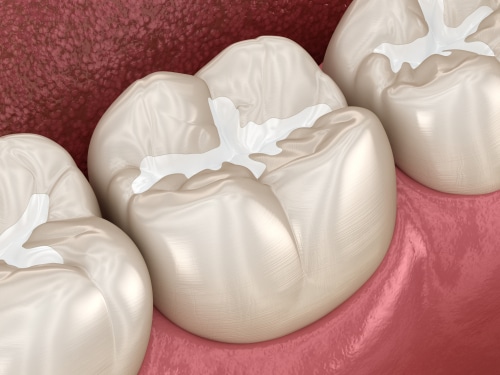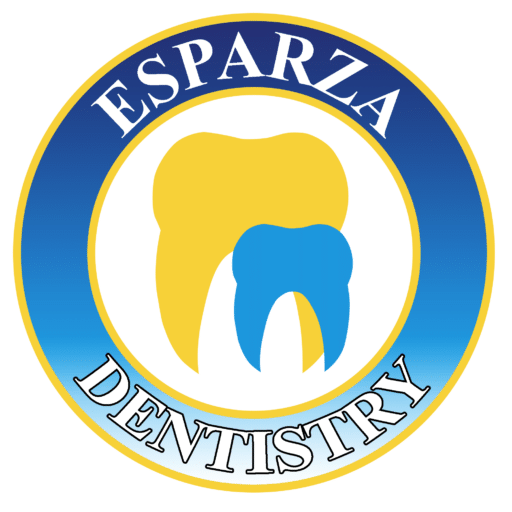Dental Sealants in Ontario, CA
Sealing a deck to prevent moisture and sun exposure from damaging the wood is common practice, but did you know that you can seal your teeth too? When you seal a tooth, you block bacteria from accumulating in vulnerable cracks and crevices, which prevents cavities. In the US, cavities are the most common chronic disease among children, and over a quarter of adults have untreated tooth decay. Though prevalent, cavities are entirely preventable. Dental sealants help to prevent decay from developing, saving you and your family valuable time and money treating cavities.
At Esparza Dentistry, we apply dental sealants as a preventative measure that keeps your smile radiant and healthy for years.
What Are Dental Sealants?
Grooves in your teeth are vulnerable to decay because they trap food particles that feed the bacteria in your mouth. When bacteria and food mix, they generate acids. The combination of bacteria, food particles, acids, and saliva creates plaque. If not removed, the acids in plaque wear away your enamel, leading to cavities.
Dental sealants are protective barriers that cover the tooth’s pits and fissures to prevent plaque and bacteria from accumulating. The sealant is a tooth-colored material made from resins or glass ionomers. We often apply dental sealants to the molars, where 9 out of 10 cavities occur due to their rough, uneven structure.
We recommend that parents have their children’s molars sealed as soon as they have erupted completely. For first molars, this usually occurs at age 6, while second molars typically come in at age 12. However, sealants can be applied at any time as long as a cavity has not yet formed.
Applying the Sealant
The procedure for placing sealants is quick, easy, and painless. For children and adults with dental anxiety, this is an important benefit.
We start the process by thoroughly cleaning your tooth, ensuring a pristine surface for the application. Then, we apply an etching solution so the sealant adheres securely to the tooth. After rinsing and drying the tooth, we paint on the sealant. The thin liquid flows easily into the tooth’s grooves and takes only a minute to harden. At the end of this brief procedure, you’ll be left with a durable layer of protection.
Many people wonder when they can eat after a dental sealant is applied. It is safe to eat immediately after your procedure, but we suggest refraining from chewy, sticky, or hard foods for the first 24-48 hours. These foods also affect the longevity of your dental sealant, so limiting them is recommended.
Benefits of Dental Sealants
There are many benefits of dental sealants, making them a key component of preventative dentistry.
Dental sealants are:
- Protective and effective. Studies show that sealants protect against 80% of cavities for two years and 50% of cavities for four years.
- Natural looking and feeling: Because the sealant dries in a tooth-like color, it won’t be detected even when you talk or smile. The thin material also enhances its feel in your mouth. You won’t notice the sealant at all after a few days.
- Long-lasting: Sealants can last up to 10 years with proper care. Although hard, sticky, and chewy foods can dislodge or chip dental sealants, it is easy to touch up or replace the sealant.
- Easy to clean: Deep crevices are difficult, even impossible, to clean thoroughly, even with the best toothbrushes. Sealants close those cracks, making it easier for you to clean the tooth effectively.
- Tried and true: Dental sealants have been used in dentistry since the 1960s to effectively prevent cavities. They are endorsed by several health organizations, including the American Dental Association, the American Academy of Pediatric Dentistry, and the Centers for Disease Control and Prevention.
Caring for Dental Sealants
While sealants help keep teeth healthy, proper care will extend the life of the sealant and ensure optimal oral health for many years. Follow the recommendations below to keep your smile radiant:
- Brush your teeth twice per day for at least two minutes each time. Use a soft-bristled toothbrush and brush gently at a 45-degree angle.
- Floss daily. While sealants cover the tooth’s surface, food and bacteria can still build up in the spaces between your teeth and along your gum line.
- Use an antimicrobial mouthwash to fight tooth decay.
- Don’t use your teeth as a tool. Opening packaging with your teeth can cause damage to your teeth, sealant, and soft tissues.
- Avoid chewing ice and eating hard, sticky, or chewy foods and candies. Doing so can dislodge or chip the sealant.
Maintaining your regular dental checkups and cleanings will also help keep your sealants in good condition.
Frequently Asked Questions
Are Sealants Just for Children?
No! While early prevention of cavities in children is part of a comprehensive dental plan, anyone can suffer from tooth decay. In fact, we tend to experience more tooth decay as we age. As long as you haven’t developed a full-blown cavity, we can apply a dental sealant.
What Are the Differences Between Fillings and Sealants?
Dental fillings and sealants both fill crevices in your teeth, but they serve different purposes. Fillings are used to treat cavities, while sealants are used to prevent them from forming in the first place. Applying a sealant is simpler than placing a filling and more cost-effective. Sealants also maintain the tooth’s structure to keep it healthy. Although fillings effectively repair teeth damaged from decay, a tooth without a cavity is inherently stronger than one with a filling.
Does Fluoride Work the Same as Dental Sealants?
Both fluoride and sealants are part of a comprehensive cavity prevention plan. Sealants work as a shield to keep germs and food from gathering in the tooth’s grooves. Fluoride—a mineral in toothpaste and varnishes—strengthens the teeth to prevent cavity formation. While both are pillars of cavity prevention, sealants offer a more long-lasting approach. A 2022 study that evaluated the use of fluoride varnish and dental sealants for children with autism suggests that when used together, teeth are more protected than when fluoride varnish is applied alone.
Can Bacteria Get Trapped Underneath the Sealant?
When applied properly, the sealant creates a tight-fitting seal that prevents decay. Bacteria and debris cannot enter the pit and fissures of the tooth once we apply dental sealant.
Does Insurance Cover Dental Sealants?
Dental sealants are a budget-friendly and proactive procedure that can save you money later on. Because dental sealants are a preventative measure, most insurance plans cover them, but they may include age limits. It’s always best to speak with your provider to determine which dental procedures are covered and to what extent.
Dental Sealants Defend Against Decay
Seal out cavities and safeguard your smile with dental sealants—a simple, painless, and cost-effective preventative treatment. Dental sealants create a strong shield against decay, protecting vulnerable areas from accumulating bacteria and food particles that cause cavities. While the application is incredibly quick, dental sealants provide long-lasting protection.
At Esparza Dentistry, we take pride in delivering excellent dental care and fostering lasting relationships with our valued patients and their families. With over 25 years of dedicated service to families in Ontario, Chino, and Rialto, you can trust us with your dental sealant application.
Contact us today to take the first steps toward a cavity-free future.
